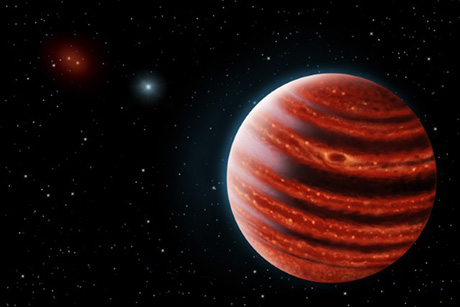Savransky savors role in major exoplanet discovery
By Blaine Friedlander


Dmitry Savransky is passionate about his role in finding 51 Eridani b, an extrasolar planet – planets found outside of our own solar system – about 100 light-years away, as part of a new survey of exoplanets.
“This exoplanet project happens to be my favorite,” said Savransky ’04, Cornell assistant professor of mechanical engineering.
Detected and directly imaged by the Gemini Planet Imager (GPI), 51 Eridani b shares characteristics of a young Jupiter. GPI, led by Stanford University physics professor Bruce Macintosh, announced the discovery in the journal Science, Aug. 13.
GPI was designed to discover and analyze faint, young planets orbiting bright stars. “Many of the exoplanets astronomers have imaged before have atmospheres that look like very cool stars,” said Macintosh, who led construction of GPI and now leads its planet-hunting survey. “This one looks like a planet,” he said.
“This is exactly the kind of planet we envisioned discovering when we designed GPI,” said James Graham, professor at the University of California, Berkeley, and the project scientist for GPI.
Savransky, a member of Cornell’s Carl Sagan Institute: Pale Blue Dot and Beyond, co-leads the observing and operations subteam of the GPI Exoplanet Survey (GPIES). He wrote software for the instrument to align itself automatically, which he said is “a necessary step in the process of blocking starlight to detect planets.”
In addition to having a Cornell server host observation software tools, Savransky provides remote support to the survey’s observing teams in Chile.
“My group at Cornell hosts many of the tools used by the GPIES team to conduct the survey and supports the instrument itself – online databases and tools developed by me and other GPIES team members that allow our large, widely distributed team to plan observations in real time and have near-instant access to data,” he said.
As the lowest-mass planet ever imaged, 51 Eridani b is also the coldest (800 degrees Fahrenheit) – and features the strongest atmospheric methane signal on record. Previous Jupiter-like exoplanets had only faint traces of methane.
Said Stanford’s Macintosh: “51 Eri b is the first one that’s cold enough and close enough to the star that it could have indeed formed right where it is the old-fashioned way. This planet really could have formed the same way Jupiter did. That whole solar system could be a lot like ours.”
Not a stranger to large, complex team projects, as an undergraduate at Cornell’s College of Engineering, Savransky worked on the panoramic camera (PanCam) on the Mars rovers Spirit and Opportunity, as well as on the uplink/downlink crews sending instructions and receiving images.
In his statistical analysis work, Savransky relishes accumulating data about various solar systems and providing information on how other systems evolve. “This planet we’ve found is young – only about 20 million years old,” he said. “These discoveries close the loop for theorists on how planetary systems develop.”
Media Contact
Get Cornell news delivered right to your inbox.
Subscribe